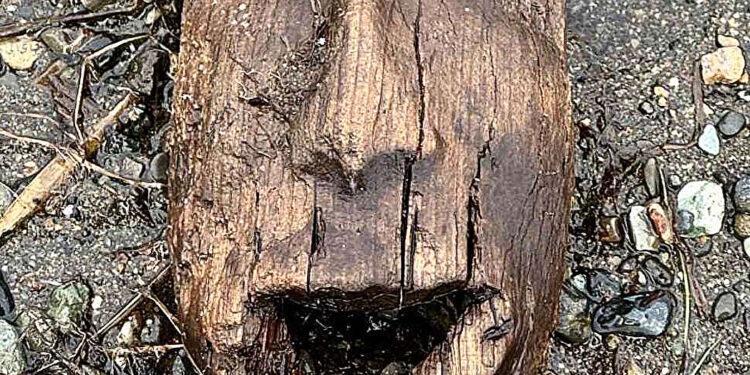This photo provided by Richard Arden Knecht shows a wooden mask found washed away by waters from a culturally significant Yup’ik archaeological site, known as the Nunalleq site, in Quinhagak, Alaska, in October 2025. Credit: Richard Arden Knecht via AP
A fragment of a mask preserved for hundreds of years in permafrost lay in the mud of a low tide in the community of Quinhagak in western Alaska. Wooden spoons, toys, a fishing lure and other items were scattered, in some cases for miles, along the beach.
The Yup’ik community near the edge of the Bering Sea was spared the widespread devastation wrought by the remnants of Typhoon Halong on its neighbors further west earlier this month. But it suffered a different kind of hit: High winds and storm surge engulfed dozens of feet of shoreline, disrupting a culturally significant archaeological site and possibly washing away thousands of discovered artifacts.
About 1,000 pieces, including masks and wooden tools, were found in Quinhagak after the storm ravaged parts of southwest Alaska on Oct. 11-12. But many other pieces, perhaps as many as 100,000, were scattered, said Rick Knecht, an archaeologist who worked on the Nunalleq, or old village, project for 17 years. This is approximately the number of pieces previously recovered from the archaeological site.
Meanwhile, freezing temperatures and ice moved into the area, stalling immediate efforts to find and recover more artifacts displaced during searches by four-wheel vehicle and on foot.
Knecht called what happened a major loss. The site has yielded the world’s largest collection of pre-European Yup’ik artifacts. Much of what is known about Yup’ik life before the arrival of outsiders stems from the project, said Knecht, a senior lecturer emeritus in archeology at the University of Aberdeen in Scotland.
This photo provided by Richard Arden Knecht shows various tools, utensils and other artifacts that were recovered after Typhoon Halong and scattered at an important Yup’ik archaeological site, known as the Nunalleq site, in Quinhagak, Alaska, in October 2025. Credit: Richard Arden Knecht via AP
“When there are holes or disruptions in the site, it’s like trying to read a book with holey pages. You’re going to miss some things,” he said. “And the bigger those holes get, the weaker the story gets. There are a few holes in the book right now.”
Although the name of the original village is not known, it was attacked by another village and burned down around 1650, he said. Knecht worked with elders and others in Quinhagak to combine their traditional knowledge with technology and techniques used by archeology teams to study the past together.
Quinhagak has a population of around 800 and collecting subsistence food is of crucial importance to them.
The storm scattered artifacts from a site long preserved by permafrost, Knecht said. A long-standing concern is the threat that climate change – melting permafrost, coastal erosion, the risk of more frequent or stronger storms – poses to the site, he said.
This photo provided by Richard Arden Knecht shows Warren Jones, left, and Mike Smith posing with a wooden mask fragment that was washed away by water from the Nunalleq archaeological site in Quinhagak, Alaska, in October 2025, after Typhoon Halong made landfall in western Alaska. Credit: Richard Arden Knecht via AP
This poses risks to the community itself. Erosion threatens Quinhagak’s main infrastructure, including a sewage lagoon, homes and fishing camps. Thawing permafrost is also disruptive and weakens buildings, according to a 2024 report from the Alaska Native Tribal Health Consortium.
The excavation project itself began after artifacts began appearing on the beach around 2007. Part of the site that was washed away had already been excavated.
“There was a large part of the site where we had only gone halfway and left it for later because we had prioritized the parts of the site most at risk from marine erosion,” Knecht said.
When he left in July, there was a buffer of about 30 feet out to sea. The storm washed away the buffer and another 30 feet of the site, he said. It also left what Knecht described as piano-sized clumps of tundra on the mud flats.
-
This photo provided by Richard Arden Knecht shows clay cliffs left in the aftermath of Typhoon Halong on a beach in Quinhagak, Alaska, in October 2025. Credit: Richard Arden Knecht via AP
-
The shore of Kuskokwim Bay on the Bering Sea is seen Monday, Oct. 27, 2025, near Kongiganak, Alaska. Credit: AP Photo/Lindsey Wasson
Knecht did not recognize the site at first after Halong.
“I walked right by it because all the landmarks I’m used to on the beach and at the site were gone or changed,” he said.
Work to preserve the salvaged items included soaking the wood in sea salts and placing the pieces in special chemicals that will help them hold together when they dry, he said. If one simply took one of the wooden objects from the beach and left it to dry, they would “break into pieces, sometimes within hours.”
There is a laboratory at the Quinhagak Museum where the artifacts are kept.
Archaeologists hope to return to the site next spring for a “salvage excavation” of the layers exposed by the storm, he said. In some ways, it feels like the teams saw the site in 2009: “We have this raw site with artifacts sticking out in every way,” he said. “So we’re starting from scratch.”
© 2025 The Associated Press. All rights reserved. This material may not be published, broadcast, rewritten or redistributed without permission.
Quote: Archaeological site in Alaska which highlights the life of the first Yup’ik ravaged by ex-typhoon Halong (October 30, 2025) retrieved on October 30, 2025 from
This document is subject to copyright. Except for fair use for private study or research purposes, no part may be reproduced without written permission. The content is provided for informational purposes only.



